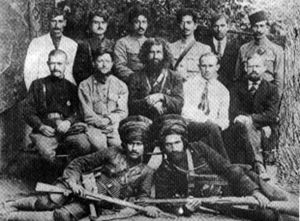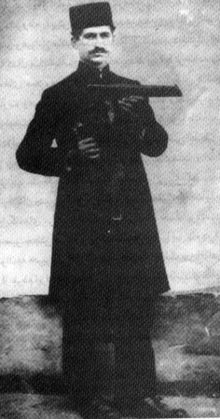- Jangal movement of Gilan
-
The Jangal (Jungle) movement, in Gilan, was a rebellion against the monarchist rule of the Qajar central government of Iran. It is considered as the extension of Constitutional Revolution of Iran[citation needed] and lasted from 1914 to 1921.
Contents
History of the movement
In 1914 Mirzâ Kuçak Xân met in Tehran with other prominent figures of the Constitutional Revolution and helped organize a plan of reform for Iran, which called for the total independence of the nation, land and social reforms for the poor, and Islamic unity. Obstacles to this program included foreign imperialists, the landed elites, and tribal leaders. From the constitutionalist perspective, the Tehran government had by this time lost its independence and had fallen completely under the influence of the British and Russians. Kuchak Khan and the Jangalis then formally disavowed the central government and proclaimed their intention to free Iran from both the foreign influences and the domination of landed elites and tribal rulers.
During the next few years, the Jangalis fought against the Russian and British forces that had threatened to advance towards Tehran from Gilan. They also waged campaigns against the tribes and robber bandits that threatened the security of the region. At this point, the Jangali movement was still fiercely committed to Iran, rather than pursuing Gilani nationalism which had not yet become an issue.
However, after the Russian Revolution of 1917, foreign domination over the central government of Tehran was no longer as strong, and while the British continued to maintain a high level of influence over the Imperial Court, the government was now able to act more independently than before. Kouchak Khan and the Jangalis, as well as other constitutionalists and nationalists, saw this as an opportunity to join the central government and begin implementing their long-awaited democratic and social reforms. The Anglo-Persian Treaty of 1919, however, put an end to such an opportunity. The treaty was widely viewed by Iranians as having made the nation into nothing more than a British protectorate. Its chief negotiator, Prime Minister Vosough od-Dowleh, was seen as a servant of the British. Kouchak Khan thereafter made this announcement in response to the terms of the treaty:
- "My purpose and that of my friends is the independence of the state and the reforming and strengthening of the central government."
Kuchak Khan made a public declaration that he was against the idea of separating Gilan from Iran, and that Gilan would return to the jurisdiction of the central government as soon as it rejected the treaty and reformed itself. This, however, did not happen, and antagonism towards Britain and the ruling elites of the Qajar Court who were subservient to their interests grew to unprecedented heights. In June 1919, the Bolsheviks officially ended the Czarist era practice of extracting special privileges and concessions from Tehran.
 This picture was taken in May of 1920 in Bandar Anzali, Iran after the arrival of the Soviet navy in pursuit of the Russian counter-revolutionary General Denikin. Standing from right: Karbalai Hossein, Seifollah Zadeh, Saadollah Darvish, Esmail Jangali, Mir Saleh Mozafar Zadeh, Moharam Babaev. Sitting from right:Gauook (Hooshang), Kazhanov (chief Soviet commissar), Mirza Koochak Khan, Abukov (Soviet commissar), Pelayev. Lying from right: Khaloo Morad Bozorg, Khaloo Ghanbar.
This picture was taken in May of 1920 in Bandar Anzali, Iran after the arrival of the Soviet navy in pursuit of the Russian counter-revolutionary General Denikin. Standing from right: Karbalai Hossein, Seifollah Zadeh, Saadollah Darvish, Esmail Jangali, Mir Saleh Mozafar Zadeh, Moharam Babaev. Sitting from right:Gauook (Hooshang), Kazhanov (chief Soviet commissar), Mirza Koochak Khan, Abukov (Soviet commissar), Pelayev. Lying from right: Khaloo Morad Bozorg, Khaloo Ghanbar.
In May 1920 the Soviet Navy led by Raskolnikov and accompanied by Sergo Ordzhonikidze entered the Caspian port of Anzali. This mission was declared to be only in pursuit of the Russian vessels and ammunition taken to Anzali by the White Russian counter-revolutionary general Denikin, who had been given asylum by British forces in Anzali. Upon their arrival based on some preliminary communication between Mirza and the Bolsheviks, Mirza agreed to enter into an alliance with the Soviets against the British. Among the conditions was the establishment of the Soviet Republic of Gilan.
However, soon arose disagreements between Kuchak Khan and his group of advisors on one side and the Soviets and the Iranian Communist Party (evolved from the Baku based Edalat (Justice) Party)on the other. Kuchak Khan's efforts to resolve the bloody disputes by sending a petition through a delegate of two of his men to Lenin [1] did not result in a resolution. By 1921 and particularly after the agreement reached between the Soviet Union and Britain the Soviets decided to give no further support to the Gilan Republic. As a result, the government forces led by Reza Khan crushed the dispersed forces of the Republic.
Historians have tried to analyze the factors that contributed to the demise of the Jangal movement. Some of the main studies including those by Gregor Yeghikian and Ebrahim Fakhrayi (minister of Culture in Mirza's Cabinet of the Red Republic) suggest a role for both extremist actions taken by the Communist (Edalat) Party that provoked opposing religious sentiment among the public, and Mirza Kuchak Khan's religious and at times somewhat conservative views on collaboration with the Communist Party as possible factors.
Of note is that Haydar Khan e Amo-oghli (secretary-general of the Communist Party of Iran, from Baku), was arrested by Mirza's men and was later killed by the locals. This act, according to some sources, was not approved by Mirza however, was considered a reactionary and discouraging move by the Soviets. The Gilan republic lasted from June 1920 until September 1921.
Mirza and his German friend Gauook (Hooshang), while escaping the government forces died of frost bite in Khalkhal mountains. His body was decapitated by a local landlord and his head was displayed in Rasht to establish the government’s new hegemony [2] over revolution and revolutionary ideas.
Flag
The flag of the Jangal movement was a red banner with the name Kaveh (a heroic figure in the Shahnama) written upon it. This was a reference to the Derafsh-e-Kaviani (Kaviani Banner) and symbolized the movement's struggle against the monarchist central government in working to establish a democratic Iranian republic.
Further analysis
Initially, when commencing the movement, Mirza and his allies formed a union called Ettehad-e-Islam (The Islamic Union). Although in the beginning, they were in conformity over the aims of the movement, eventually the movement began witnessing considerable friction as some members had diverging tendencies toward Ahmad Shah Qajar while others such as Mirza specifically called for an Iranian "Republic." (See Tarikh-i Enghelab-i Jangal by Muhammad Ali Gilak, Rasht, 1992)
Not only did Mirza specifically use the term "Republic of Iran," as can be seen in his letters (printed in Sardar-i Jangal by Ibrahim Fakhra'i, 1963, p282), but he had also declared his interest in a "Republic" before the advent of the Communist Party of Iran. (Nehzat-i Jangal by Shapur Ravasani, ISBN 964-5799-64-3 , p59) In fact Mirza was removed from his posts in the Red republic only 17 days after the party's formation (Masa'il-i Inghilab-i Iran by Irandust, 1927, Vol 5, p132). Mirza did not seem to agree with Marxist ideology, being a devout man of faith, even though many of his allies until the end were members of the Communist Party.
Concerning other points of interest is Mirza's insistence on separating church from state. This is clearly stated in Article 5 of the Jangal Movement's Constitution, where it states: "Enfekak-e Rohaniyat az Omur-i Siyasi va Moa'ashi" ("The separation of the clergy from the affairs of politics and economics"). Mirza was himself a cleric by training.
One of the reasons for the success of Mirza's movement were his many educated reformist allies, such as Hossein Kasma'i, who was the Editor in Chief of the movement's newspaper Jangal, or Ashrafeddin Hosseini, Editor in Chief of the paper Naseem e Shomal, who died during the movement's struggle.
With the movement picking up momentum, the British, Russians, Ottomans, and Germans sent envoys to absorb the movement into their political spheres, but soon all their envoys were retracted in favor of ties with the central government in Tehran.
Mirza did however employ some German officers who were former prisoners of the British in Rasht. These officers established training camps for Mirza in Gurab Zarmokh, the movement's military headquarters. A military school was also established in Lahijan, and by 1917, the Gendarmerie and Cossack forces of Rasht had joined the movement.
The British did not take Mirza's successes lightly, and sent Captain Noel to assassinate Mirza (Fakhrai, p13). The British captain was arrested before he could take any such action. Colonel Stokes and General L.C. Dunsterville (whose troops were lightly referred to as the Dunsterforce) were further agitated by Mirza's refusal to let British troops pass through Gilan on their way up north, while Mirza had approved and guaranteed Russian troops returning north safe passage. British forces attacked Rasht as a result, and even bombed Mirza's residence using airplanes. An ultimatum was issued to Mirza by the British to surrender.
The Russians joined the British and sent in 20,000 troops to capture Mirza. Many prominent members of the movement such as Haj Ahmad Kasmai, and Dr Talequani Heshmat surrendered and the latter was executed despite the immunity that he was granted.
It must be emphasized that Mirza was not after the secession of Gilan from Iran, but rather to establish an independent Republic for all of Iran, as was clearly stressed repeatedly in his communiques.
In the wake of his final defeat and the demise of the movement, Mirza is known to have bitterly remarked in a letter shortly before his death:
- "How sad that Iranians are supportive of the dead (mordeh-parast) and still do not realize the value of this movement. Of course they will come to realize after we are gone: who we were, what we wanted to achieve, and what we did."
Historical references
- George Lenczowski (1968). Russia and the West in Iran. Greenwood Press. ISBN 0-8371-0144-1.
- Nasrollah Fatemi (1952). Diplomatic History of Persia. Russell F. Moore. LCCN 52011977., ASIN B0007DXLE2
- Ebrahim Fakhrayi, Sardar-e Jangal (The Commander of the Jungle), Tehran: Javidan,1983.
- Gregor Yaghikiyan, Shooravi and jonbesh-e jangal (The Soviet Union and the Jungle Movement), Editor: Borzouyeh Dehgan, Tehran: Novin, 1984.
- Khosro Shākeri, Milāde Zakhm: Jonbesh-e Jangal va Jomhuri-ye Shoravi-ye Socialist-e Iran (The Birth of the Lesion: The Jangali movement and the Consultative Socialist Republic of Iran), in Persian, first edition, 715 p. (Akhtarān Press, Tehran, 2007). ISBN 978-964-8897-27-2
See also
Categories:- History of Iran
- Iran–Soviet Union relations
- History of Gilan Province
Wikimedia Foundation. 2010.

